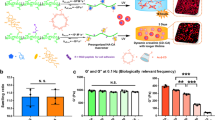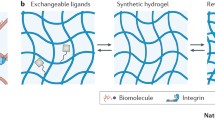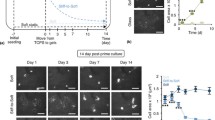Abstract
Many cell-matrix interaction studies have proved that dynamic changes in the extracellular matrix (ECM) are crucial to maintain cellular properties and behaviors. Thus, developing materials that can recapitulate the dynamic attributes of the ECM is highly desired for three-dimensional (3D) cell culture platforms. To this end, we sought to develop a hydrogel system that would enable dynamic and reversible turning of its mechanical and biochemical properties, thus facilitating the control of cell culture to imitate the natural ECM. Herein, a hydrogel with dynamic mechanics and a biochemistry based on an addition-fragmentation chain transfer (AFCT) reaction was constructed. Thiol-modified hyaluronic acid (HA) and allyl sulfide-modified ε-poly-L-lysine (EPL) were synthesized to form hydrogels, which were non-swellable and biocompatible. The reversible modulus of the hydrogel was first achieved through the AFCT reaction; the modulus can also be regulated stepwise by changing the dose of UVA irradiation. Dynamic patterning of fluorescent markers in the hydrogel was also realized. Therefore, this dynamically controllable hydrogel has great potential as a 3D cell culture platform for tissue engineering applications.
Similar content being viewed by others
References
Lei, K. F.; Chang, C. H.; Chen, M. J. Paper/PMMA hybrid 3D cell culture microfluidic platform for the study of cellular crosstalk. ACS Appl. Mater. Interfaces 2017, 9, 13092–13101.
Kim, J.; Hayward, R. C. Mimicking dynamic in vivo environments with stimuli-responsive materials for cell culture. Trends Biotechnol. 2012, 30, 426–439.
Wu, Y.; Wang, L.; Guo, B.; Ma, P. X. Interwoven aligned conductive nanofiber yarn/hydrogel composite scaffolds for engineered 3D cardiac anisotropy. ACS Nano 2017, 11, 5646–5659.
Ming, Z.; Fan, J.; Bao, C.; Xue, Y.; Lin, Q.; Zhu, L. Photogenerated aldehydes for protein patterns on hydrogels and guidance of cell behavior. Adv. Funct. Mater. 2018, 28, 1706918.
Kocen, R.; Gasik, M.; Gantar, A.; Novak, S. Viscoelastic behaviour of hydrogel-based composites for tissue engineering under mechanical load. Biomed. Mater. 2017, 12, 025004.
Cai, Z.; Huang, K.; Bao, C.; Wang, X.; Sun, X.; Xia, H.; Lin, Q.; Yang, Y.; Zhu, L. Precise construction of cell-instructive 3D microenvironments by photopatterning a biodegradable hydrogel. Chem. Mater. 2019, 31, 4710–4719.
Truong, V. X.; Li, F.; Forsythe, J. S. Versatile bioorthogonal hydrogel platform by catalyst-free visible light initiated photodimerization of anthracene. ACS Macro Lett. 2017, 6, 657–662.
Prasopthum, A.; Deng, Z.; Khan, I. M.; Yin, Z.; Guo, B.; Yang, J. Three dimensional printed degradable and conductive polymer scaffolds promote chondrogenic differentiation of chondroprogenitor cells. Biomater. Sci. 2020, 8, 4287–4298.
Deng, C.; Wang, R.; Chen, W.; Meng, F. H.; Cheng, R.; Zhong, Z. Y. Design and synthesis of rapidly photo-crosslinkable bioactive biodegradable hydrogels. Acta Polymerica Sinica (in Chinese) 2013, 695–704.
Ma, X. B.; Yang, R.; Sekhar, K. P. C.; Chi, B. Injectable hyaluronic acid/poly(γ-glutamic acid) hydrogel with step-by-step tunable properties for soft tissue engineering. Chinese J. Polym. Sci. 2021, 39, 957–965.
Liu, S. S.; Xiang, Z. H.; Ma, Z. F.; Wu, X. W.; Shi, Q.; Wong, S. C.; Yin, J. H. Surface patterning of self-healing P(MMA/nBA) copolymer for dynamic control cell behaviors. Chinese J. Polym. Sci. 2020, 38, 696–703.
Lu, D.; Zhu, M.; Wu, S.; Lian, Q.; Wang, W.; Adlam, D.; Hoyland, J. A.; Saunders, B. R. Programmed multiresponsive hydrogel assemblies with light-tunable mechanical properties, actuation, and fluorescence. Adv. Funct. Mater. 2020, 30, 1909359.
Guo, B.; Qu, J.; Zhao, X.; Zhang, M. Degradable conductive self-healing hydrogels based on dextran-graft-tetraaniline and N-carboxyethyl chitosan as injectable carriers for myoblast cell therapy and muscle regeneration. Acta Biomater. 2019, 84, 180–193.
Uto, K.; Tsui, J. H.; DeForest, C. A.; Kim, D. H. Dynamically tunable cell culture platforms for tissue engineering and mechanobiology. Prog. Polym. Sci. 2017, 65, 53–82.
Lu, D.; Zhu, M.; Wu, S.; Wang, W.; Lian, Q.; Saunders, B. R. Triply responsive coumarin-based microgels with remarkably large photo-switchable swelling. Polym. Chem. 2019, 10, 2516–2526.
DeForest, C. A.; Tirrell, D. A. A photoreversible protein-patterning approach for guiding stem cell fate in three-dimensional gels. Nat. Mater. 2015, 14, 523–531.
Blow, N. Cell culture: building a better matrix. Nat. Methods 2009, 6, 619–622.
Shadish, J. A.; Benuska, G. M.; DeForest, C. A. Bioactive site-specifically modified proteins for 4D patterning of gel biomaterials. Nat. Mater. 2019, 18, 1005–1014.
Rosales, A. M.; Anseth, K. S. The design of reversible hydrogels to capture extracellular matrix dynamics. Nat. Rev. Mater. 2016, 1, 15012.
Brown, T. E.; Marozas, I. A.; Anseth, K. S. Amplified photodegradation of cell-laden hydrogels via an addition-fragmentation chain transfer reaction. Adv. Mater. 2017, 29, 1605001.
Scott, T. F.; Schneider, A. D.; Cook, W. D.; Bowman, C. N. Photoinduced plasticity in cross-linked polymers. Science 2005, 308, 1615–1617.
Grim, J. C.; Brown, T. E.; Aguado, B. A.; Chapnick, D. A.; Viert, A. L.; Liu, X.; Anseth, K. S. A Reversible and repeatable thiol-ene bioconjugation for dynamic patterning of signaling proteins in hydrogels. ACS Cent. Sci. 2018, 4, 909–916.
Gandavarapu, N. R.; Azagarsamy, M. A.; Anseth, K. S. Photo-click living strategy for controlled, reversible exchange of biochemical ligands. Adv. Mater. 2014, 26, 2521–2526.
Yavitt, F. M.; Brown, T. E.; Hushka, E. A.; Brown, M. E.; Gjorevski, N.; Dempsey, P. J.; Lutolf, M. P.; Anseth, K. S. The effect of thiol structure on allyl sulfide photodegradable hydrogels and their application as a degradable scaffold for organoid passaging. Adv. Mater. 2020, 32, 1905366.
Hoang, T. T.; Smith, T. P.; Raines, R. T. A boronic acid conjugate of angiogenin that shows ROS-responsive neuroprotective activity. Angew. Chem. Int. Ed. 2017, 56, 2619–2622.
Vercruysse, K. P.; Marecak, D. M.; Marecek, J. F.; Prestwich, G. D. Synthesis and in vitro degradation of new polyvalent hydrazide cross-linked hydrogels of hyaluronic acid. Bioconjugate Chem. 1997, 8, 686–694.
Snow, A.; Foos, E. Conversion of alcohols to thiols via tosylate intermediates. Cheminform 2003, 38, 509–512.
Zhang, Y.; Heher, P.; Hilborn, J.; Redl, H.; Ossipov, D. A. Hyaluronic acid-fibrin interpenetrating double network hydrogel prepared in situ by orthogonal disulfide cross-linking reaction for biomedical applications. Acta Biomater. 2016, 38, 23–32.
Hornof, M. D.; Kast, C. E.; Bernkop-Schnürch, A. In vitro evaluation of the viscoelastic properties of chitosan-thioglycolic acid conjugates. Eur. J. Pharm. Biopharm. 2003, 55, 185–190.
Ni, M.; Peng, H.; Liao, Y.; Yang, Z.; Xue, Z.; Xie, X. 3D image storage in photopolymer/ZnS nanocomposites tailored by “photoinitibitor”. Macromolecules 2015, 48, 2958–2966.
Rong, Y.; Zhang, Z.; He, C.; Chen, X. Bioactive polypeptide hydrogels modified with RGD and N-cadherin mimetic peptide promote chondrogenic differentiation of bone marrow mesenchymal stem cells. Sci. China Chem. 2020, 63, 1100–1111.
Chircov, C.; Grumezescu, A.; Bejenaru, L. Hyaluronic acid-based scaffolds for tissue engineering. Rom. J. of Morphol. Embryo. 2018, 59, 71–76.
Xi, Y.; Ge, J.; Guo, Y.; Lei, B.; Ma, P. X. Biomimetic elastomeric polypeptide-based nanofibrous matrix for overcoming multidrug-resistant bacteria and enhancing full-thickness wound healing/skin regeneration. ACS Nano 2018, 12, 10772–10784.
Zou, Y. J.; He, S. S.; Du, J. Z. ε-Poly(L-lysine)-based hydrogels with fast-acting and prolonged antibacterial activities. Chinese J. Polym. Sci. 2018, 36, 1239–1250.
Lee, I. C.; Wu, Y. C.; Cheng, E. M.; Yang, W. T. Biomimetic niche for neural stem cell differentiation using poly-L-lysine/hyaluronic acid multilayer films. J. Biomater. Appl. 2014, 29, 1418–1427.
Bermejo-Velasco, D.; Azémar, A.; Oommen, O. P.; Hilborn, J.; Varghese, O. P. Modulating thiol pKa promotes disulfide formation at physiological pH: an elegant strategy to design disulfide cross-linked hyaluronic acid hydrogels. Biomacromolecules 2019, 20, 1412–1420.
Elbini Dhouib, I.; Jallouli, M.; Annabi, A.; Gharbi, N.; Elfazaa, S.; Lasram, M. M. A mini review on N-acetylcysteine: an old drug with new approaches. Life Sci. 2016, 151, 359–363.
Ma, Y.; Lin, M.; Huang, G.; Li, Y.; Wang, S.; Bai, G.; Lu, T. J.; Xu, F. 3D spatiotemporal mechanical microenvironment: a hydrogel-based platform for guiding stem cell fate. Adv. Mater. 2018, 30, 1705911.
Truong, V. X.; Tsang, K. M.; Simon, G. P.; Boyd, R. L.; Evans, R. A.; Thissen, H.; Forsythe, J. S. Photodegradable gelatin-based hydrogels prepared by bioorthogonal click chemistry for cell encapsulation and release. Biomacromolecules 2015, 16, 2246–2253.
Song, G.; Ju, Y.; Shen, X.; Luo, Q.; Shi, Y.; Qin, J. Mechanical stretch promotes proliferation of rat bone marrow mesenchymal stem cells. Colloid. Surface. B 2007, 58, 271–277.
Acknowledgments
This work was financially supported by the National Natural Science Foundation of China (Nos. 21803069 and 21975249).
Author information
Authors and Affiliations
Corresponding authors
Additional information
Notes
The authors declare no competing financial interest.
Electronic Supplementary Information
Rights and permissions
About this article
Cite this article
Wu, HY., Yang, L., Tu, JS. et al. Hydrogels with Dynamically Controllable Mechanics and Biochemistry for 3D Cell Culture Platforms. Chin J Polym Sci 40, 38–46 (2022). https://doi.org/10.1007/s10118-021-2639-3
Received:
Accepted:
Published:
Issue Date:
DOI: https://doi.org/10.1007/s10118-021-2639-3




